The Lion: King of the Savannah and Icon of Strength
Lions, often referred to as the “king of the jungle,” are majestic big cats known for their strength, social behavior, and cultural significance. As one of the most recognizable and revered animals in the world, lions play a crucial role in their ecosystems and captivate the human imagination. This article explores the characteristics, behavior, habitat, and conservation of lions.
Introduction to Lions
Lions (Panthera leo) are large carnivorous mammals belonging to the family Felidae. Known for their powerful build and iconic manes, they are the second-largest big cats after tigers. Lions are primarily found in the grasslands and savannas of Africa, with a small population in India.
- Scientific Classification: Panthera leo.
- Common Names: African lion, Asiatic lion.
Characteristics of Lions
1. Physical Traits
Lions are distinguished by their muscular bodies, large heads, and, in males, a prominent mane.
- Size: Male lions typically weigh between 330 and 550 pounds, while females weigh between 265 and 400 pounds.
- Mane: The mane, unique to male lions, varies in color and size, often darkening with age. It serves as a sign of strength and maturity.
- Coat: Lions have a tawny yellow coat that helps them blend into their surroundings.
2. Adaptations
Lions possess several adaptations that make them formidable predators.
- Sharp Claws and Teeth: Used for gripping and tearing prey.
- Keen Senses: Excellent vision, particularly in low light, and a strong sense of smell.
- Powerful Build: Their muscular bodies and strong limbs allow them to tackle large prey.
Social Structure and Behavior
1. Pride Dynamics
Lions are the only truly social big cats, living in groups called prides.
- Composition: A pride typically consists of related females, their offspring, and a coalition of males.
- Roles: Females are primarily responsible for hunting and caring for cubs, while males defend the territory and pride from rivals.
2. Hunting and Diet
Lions are apex predators, primarily hunting large herbivores.
- Prey: Includes zebras, wildebeest, buffalo, and antelope. Lions may also scavenge or steal prey from other predators.
- Hunting Strategy: Lions often hunt in groups, using coordinated tactics to ambush and take down prey.
3. Communication
Lions communicate using a variety of vocalizations, body language, and chemical signals.
- Roaring: A lion’s roar can be heard up to 5 miles away and serves to establish territory and communicate with pride members.
- Social Behaviors: Grooming and nuzzling strengthen social bonds within the pride.
Habitat and Distribution
1. African Lions
African lions are found in various habitats across sub-Saharan Africa.
- Savannas and Grasslands: Prefer open plains where prey is abundant.
- Woodlands and Semi-Deserts: Also found in denser habitats, adapting to a range of environments.
2. Asiatic Lions
Asiatic lions are restricted to the Gir Forest in Gujarat, India.
- Habitat: Reside in dry deciduous forests and scrublands.
- Differences: Slightly smaller than African lions with a less developed mane and a fold of skin along the belly.

Conservation Status and Efforts
1. Threats to Lions
Lions face several threats that have led to a decline in their populations.
- Habitat Loss: Due to human encroachment, agriculture, and deforestation.
- Human-Wildlife Conflict: Lions sometimes prey on livestock, leading to retaliatory killings by humans.
- Poaching: Targeted for their bones and body parts used in traditional medicine and for trophies.
2. Conservation Initiatives
Efforts to protect lions focus on habitat preservation, conflict mitigation, and community engagement.
- Protected Areas: National parks and wildlife reserves provide safe habitats and reduce human-lion conflicts.
- Anti-Poaching Measures: Enhanced law enforcement and patrols to prevent illegal hunting.
- Community-Based Conservation: Involving local communities in conservation efforts through education and economic incentives.
3. Success Stories
- Gir National Park: Conservation efforts have helped stabilize and increase the population of Asiatic lions in India.
- Southern Africa: Successful reintroduction programs and translocations have helped restore lion populations in certain regions.
Lions in Culture and Mythology
1. Symbolism
Lions have been symbols of courage, strength, and royalty across various cultures.
- African Cultures: Seen as symbols of power and leadership.
- Western Cultures: Often depicted as regal and noble creatures in literature and heraldry.
2. Modern Representation
Lions are prominent in popular culture, from books and movies to logos and mascots.
- The Lion King: A famous animated film that portrays lions as the rulers of the savannah.
- Sports Teams: Many sports teams use lions as mascots, representing strength and bravery.
Conclusion
Lions are iconic animals that embody the majesty and complexity of the natural world. Understanding their behavior, ecological roles, and the challenges they face is crucial for their conservation. By supporting conservation initiatives and promoting sustainable practices, we can help ensure that future generations continue to marvel at these magnificent creatures.
Tags: Lions, African Lions, Asiatic Lions, Lion Conservation, Wildlife Protection, Big Cats
This article provides a comprehensive overview of lions, covering their characteristics, behavior, habitats, and conservation, appealing to readers interested in wildlife and nature conservation.